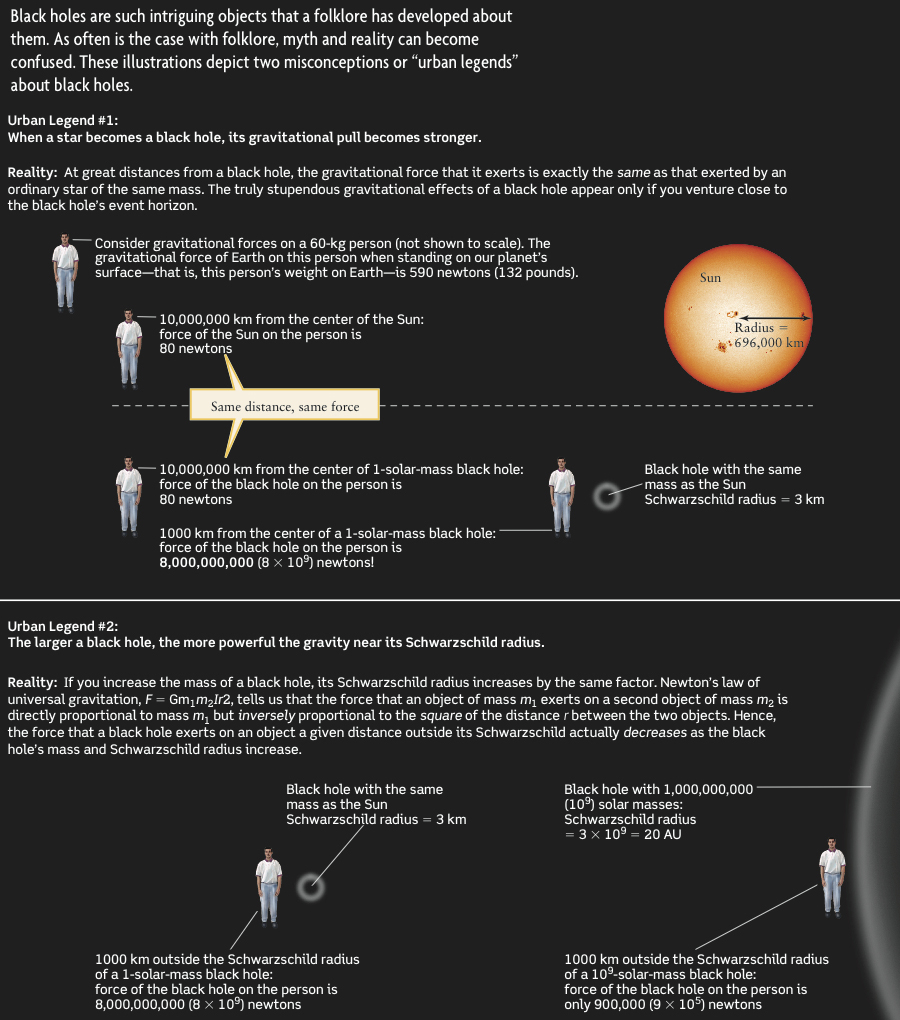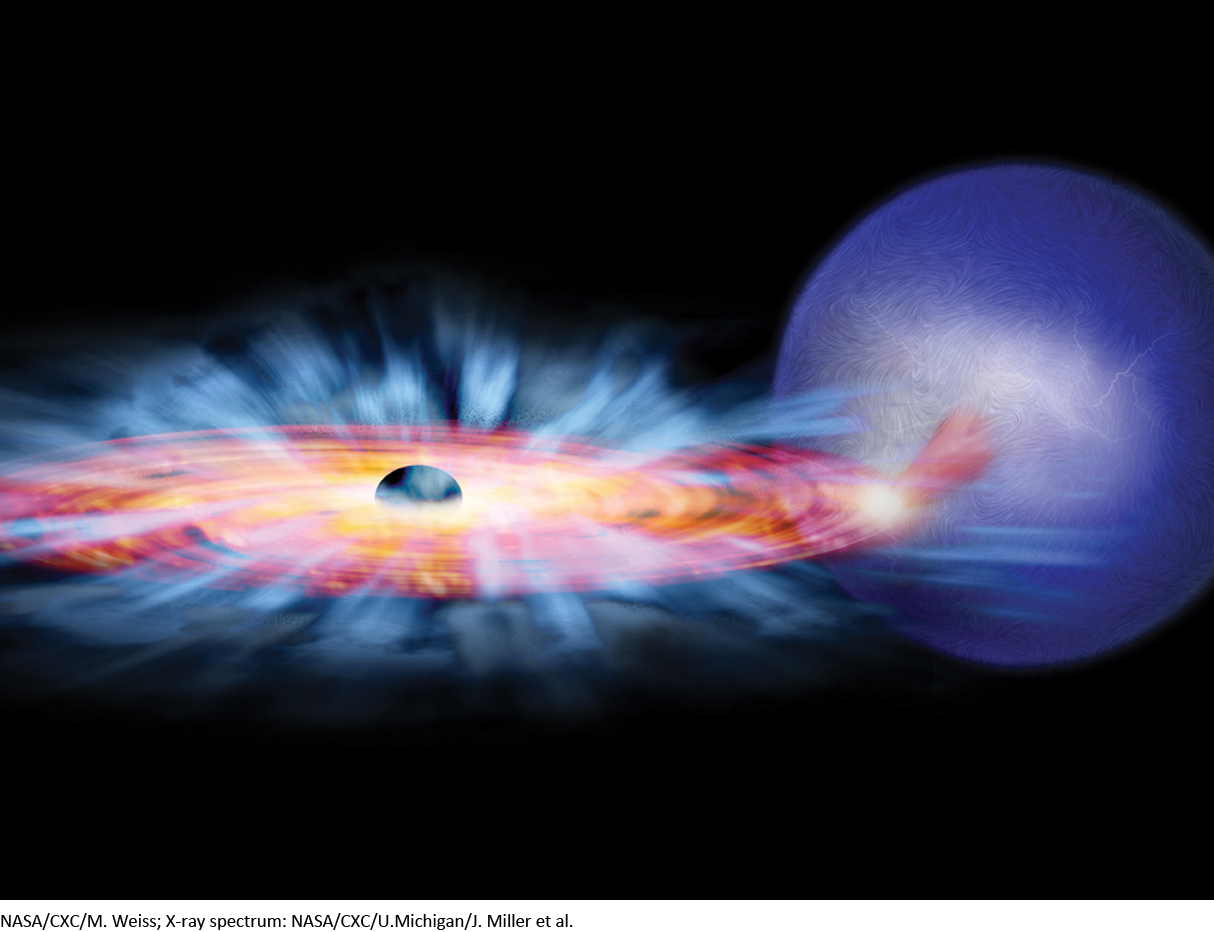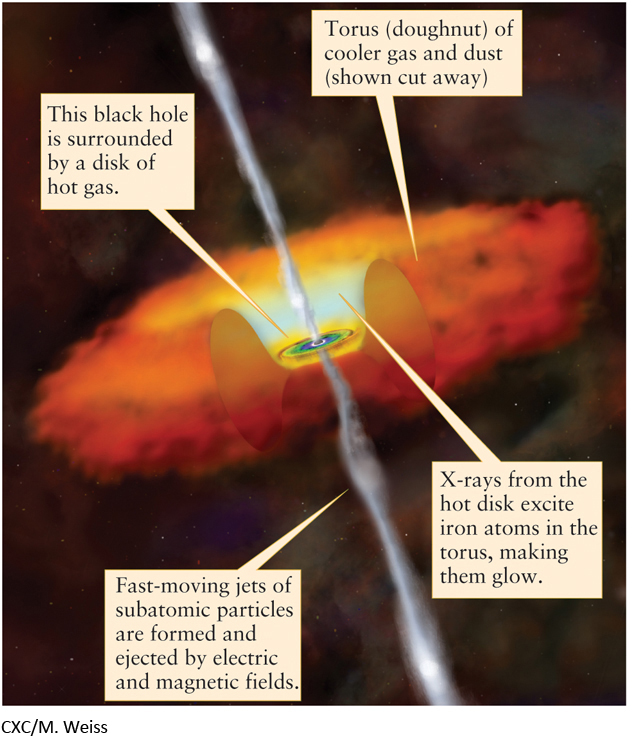12-4 Black holes cannot be seen directly
 Go to Video 12-3
Go to Video 12-3
What might a black hole look like through a telescope? Finding black holes is a difficult business indeed. Because light cannot escape from inside the black hole, you cannot observe one directly, in the same way that you can observe a star or a planet. The best you can hope for is to detect the effects of a black hole’s powerful gravity.
Finding Black Holes
Close binary star systems where two stars orbit around one another offer one way to find black holes that have mass comparable to those of ordinary stars. Imagine that one of the stars in a binary system evolves into a black hole—the more massive of the two stars evolving faster. If the black hole orbits close enough to the other, ordinary star in the system, gravitational attraction can draw matter from the ordinary star into the black hole. If we can detect radiation coming from this “stolen” matter as it moves toward the black hole, we can infer the presence of the black hole.
291
COSMIC CONNECTIONS Black Hole “urban Legends”

292
The first sign of such emissions from a binary system with a black hole came shortly after the launch of the Uhuru X-ray–detecting satellite in 1971. Astronomers became intrigued with an X-ray source designated Cygnus X-1. The X-rays emitted from Cygnus X-1 are highly variable and irregular; they flicker on timescales as short as one-hundredth of a second. One of the fundamental concepts in physics is that nothing can travel faster than the speed of light. Because of this limitation, an object cannot flicker faster than the time required for light to travel across the object. Because light travels 3000 km in a hundredth of a second, Cygnus X-1 can be no more than 1800 miles (3000 km), or about one-quarter the size of Earth. Yet other observations show that Cygnus X-1 must have a mass of at least 7 solar masses, ruling out either a white dwarf or a neutron star. Only material moving quickly toward a black hole could cause such highly variable X-ray emissions.
It is important to emphasize that the X-rays do not come from the black hole itself. Rather, gas captured from a nearby star goes into orbit about the hole, forming an accretion disk about 2.5 million miles (4 × 106 km) in diameter (Figure 12-14). As material in the disk gradually spirals in toward the hole, friction heats the gas to temperatures approaching 2 × 106 K. In the final 125 miles (200 km) above the hole’s “surface,” these extremely hot gases emit the X-rays that our satellites detect. Presumably the X-ray flickering is caused by small hot spots on the rapidly rotating inner edge of the accretion disk. In this way, the black hole’s existence is announced by doomed gases just before they plunge to oblivion.
Black holes can only be “seen” by the effects they have on surrounding matter.

Question
ConceptCheck 12-11: If a gravitationally bound binary system now contains one black hole and one red giant, which of the two original stars was the more massive?
Supermassive Black Holes
 Go to Video 12-4
Go to Video 12-4
Stellar evolution makes it possible to form black holes with masses several times that of the Sun. But calculations suggest other ways to form black holes that are either extremely large or extraordinarily small.
Galaxies of stars formed in the early universe by the coalescence of gas clouds. During this formation process, some of a galaxy’s gas could have plunged straight toward the center of the galaxy, where it collected and compressed together under its own gravity. If this central clump became sufficiently dense, it could have formed a black hole. However, this black hole would be very different from ones created through the core collapse of a dying massive star. Instead, galaxies have masses of 1011 M⊙, so even a tiny percentage of the galaxy’s gas collected at its center would give rise to a supermassive black hole with a truly stupendous mass.
Since the 1970s, astronomers have found evidence suggesting the existence of supermassive black holes in other galaxies. With the advent of a new generation of optical telescopes in the 1990s, it became possible to see the environments of these suspected black holes with unprecedented detail. Figure 12-15 shows galaxy NGC 3627 as a mosaic of images from a variety of telescopes. Streams of gas jetting away from the core are visible using X-ray telescopes and are seen moving perpendicular to the plane of the disk, as in Figure 12-16.


293
By measuring the Doppler shifts of light coming from the two sides of the core, astronomers found that the heated material was orbiting around the bright object at the center of the disk at speeds of hundreds of miles per second. Given the size of the material’s orbit, and using Newton’s form of Kepler’s third law, they were able to calculate the mass of the central bright object. The answer is an amazing 1.2 billion (1.2 × 109) solar masses! What is more, the observations show that this object can be no larger than our solar system. The only possible explanation is that the object at the center of NGC 3627 is a black hole of super mass.
Dozens of other black holes in the centers of galaxies have been identified by their gravitational effect on surrounding gas and dust. Surveys of galaxies have shown that supermassive black holes are not at all unusual; most large galaxies appear to have them at their centers. As we will see in the next chapter, a black hole with several million solar masses lies at the center of our own Milky Way Galaxy, some 26,000 ly from Earth.
Question
ConceptCheck 12-12: What is the best evidence for supermassive black holes at galactic centers?